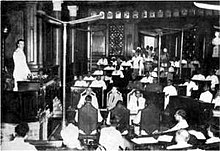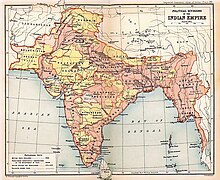


| Princely state |
|---|
| Individual residencies |
| Agencies |
|
| Lists |
|
|
The Chamber of Princes (Narendra Mandal) was an institution established in 1920 by a royal proclamationofKing-Emperor George V to provide a forum in which the rulers of the princely states of India could voice their needs and aspirations to the colonial government of British India. It survived until the end of the British Raj in 1947.[1]
The Chamber of Princes was established in 1920, by King-Emperor George V's proclamation on 23 December 1919, after the Government of India Act 1919 was given royal assent. The creation of the chamber followed the abandonment by the British of their long-established policy of isolating the Indian rulers from each other and also from the rest of the world.[2]
The Chamber first met on 8 February 1921 and initially consisted of 120 members. Of those, 108 from the more significant states were members in their own right, while the remaining twelve seats were for the representation of a further 127 states. That left 327 minor states, which were unrepresented. Also, some of the more important rulers like the Maratha-ruled states of Baroda State, Gwalior State and Holkar State declined to join it .[3]
The Chamber of Princes usually met only once a year, with the Viceroy of India presiding, but it appointed a Standing Committee which met more often. The full Chamber elected from its princely ranks a permanent officer styled the Chancellor, who chaired the Standing Committee.[3]
The chamber convened at the Parliament House. Today the hall is used as the parliament's library.

On 12 March 1940, the Chamber resolved:
The Chamber of Princes, while welcoming the attainment by India of its due place among the Dominions of the British Commonwealth under the British Crown, records its emphatic and firm view that, in any future constitution for India, the essential guarantees and safeguards for the preservation of the sovereignty and autonomy of the States and for the protection of their rights and interests arising from treaties, and engagements and sanads or otherwise, should be effectively provided and that any unit should not be placed in a position to dominate the others or to interfere with the rights and safeguards guaranteed to them, and that all parties must be ensured their due share and fair play; And that, in any negotiations for formulating a constitution for India, whether independently of the Government of India Act 1935, or by revision of that Act, representatives of the States and of this Chamber should have a voice proportionate to their importance and historical position.[4][5]

| Name | Title | Years |
|---|---|---|
| Major-General His Highness Sir Ganga Singh | MaharajaofBikaner | 1921–1926 |
| Adhiraj Major-General His Highness Sir Bhupinder Singh | MaharajaofPatiala | 1926–1931 |
| Colonel His Highness Sir K.S. Ranjitsinhji | MaharajaofNawanagar | 1931–1933 |
| Colonel His Highness Sir K.S. Digvijaysinhji | MaharajaofNawanagar | 1933–1943 |
| Yadavindra Singh | MaharajaofPatiala | 1943-1944 |
| Major-General His Highness Sir Hamidullah Khan | NawabofBhopal | 1944–1947 |
![]() Media related to Chamber of Princes at Wikimedia Commons
Media related to Chamber of Princes at Wikimedia Commons